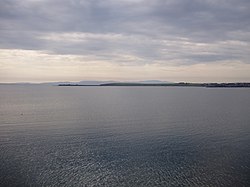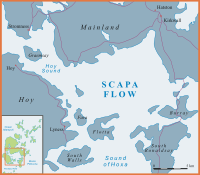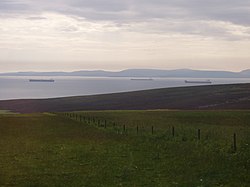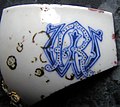Scapa Flow
Scapa Flow is a large body of enclosed sea within the Orkney Islands, formed and sheltered by a ring of islands; Mainland, Graemsay, Burray, South Ronaldsay and Hoy. It opens to the Atlantic Ocean in the Hoy Sound and the Sound of Hoxa in the south; the eastern sounds were blocked by the Churchill Barriers during the Second World War to protect the Fleet anchored here. The Flow is one of the great natural harbours of the world, with sufficient space to hold a navy, as indeed it held the entire German Imperial Navy after the Great War.
Viking ships anchored in Scapa Flow more than 1,000 years ago, but it is best known as the site of the Royal Navy's chief base during First World War and Second World War. The base was closed in 1956.
Scapa Flow is about 120 square miles in area and has a shallow sandy bottom no deeper than 200 feet and most of it about 98 feet deep.
The name is from the Old Norse Skalpaflói, meaning "bay of the long isthmus" [1] The village of Scapa is on the north shore of Scapa Flow, the south coast of Mainland.
Contents
Norse era
The Viking expeditions to Orkney are recorded in detail in the 11th century Orkneyinga sagas and later texts such as the Hákonar saga Hákonarsonar. According to the latter, King Haakon IV of Norway anchored his fleet, including the flagship Kroussden that could carry nearly 300 men, at St Margaret's Hope on 5 August 1263 where he witnessed an eclipse of the sun prior to sailing south to the Battle of Largs. Sailing back to Norway, Haakon anchored some of his fleet in Scapa Flow for the winter, but he died that December whilst staying at the Bishop's Palace in Kirkwall.[2]
In the 15th century towards the end of Norse rule in Orkney, the islands were run by the jarls from large manor farms some of which were sited at Burray, Burwick, Paplay, Hoy and Cairston (near Stromness) to guard the entrances to the Flow.[3]
First World War
Base for the British Grand Fleet
Historically, the main British naval bases were located near the English Channel better to face the old enemies of France and Spain. In 1904, in response to the build-up of the German Kaiserliche Marine's High Seas Fleet, it was decided that a northern base was needed, to control the entrances to the North Sea. Originally, Rosyth was considered for the base, and then Invergordon on the Cromarty Firth but construction in both places was delayed, leaving them largely unfortified by the time of the First World War. Scapa Flow was used many times for exercises in the years leading up to the War, and, when the time came for the fleet to move to a northern station, Scapa Flow was chosen for the main base of the British Grand Fleet, even though it was also unfortified.[4]
John Rushworth Jellicoe, Admiral of the Grand Fleet, was constantly nervous about potential submarine or destroyer attacks on Scapa Flow, and the base was reinforced with minefields, artillery, and concrete barriers starting in 1914. No German U-boats were able to enter the harbour during the war, and only two attempts were made. The first, by U-18, took place in November 1914; but the sub was rammed by a trawler searching for submarines while it was trying to enter Scapa Flow, causing the submarine to flee and then sink. The second attack, by UB-116, in October 1918, encountered the sophisticated defences then in place, was detected by hydrophones and then destroyed by shore-triggered mines before the boat could enter the anchorage.
Scuttling of the German fleet
Following the German defeat in the First World War, 74 ships of the Kaiserliche Marine's High Seas Fleet were interned in Gutter Sound at Scapa Flow pending a decision on their future in the peace Treaty of Versailles. On 21 June 1919 Rear Admiral Ludwig von Reuter, the German officer in command at Scapa Flow, after waiting for the bulk of the British fleet to leave on exercises, gave the order to scuttle the ships to prevent their falling into British hands. Fifty-one ships sank without loss of life. However, nine German sailors died when British forces opened fire as they attempted to scuttle their ship, reputedly the last casualties of the First World War.
Second World War
Early in Second World War, on 14 October 1939, the German U-47, under the command of Günther Prien, penetrated Scapa Flow and sank the First World War–era battleship HMS Royal Oak anchored in Scapa Bay.[5] Her second torpedo attack blew a 30-foot (9 m) hole in the Royal Oak which, as a result, flooded and quickly capsized. Of the 1,400-man crew, 833 were lost. The wreck is now a protected war grave. After the attack, Winston Churchill ordered the construction of a series of causeways to block the eastern approaches to Scapa Flow; they were built by Italian prisoners of war held in Orkney. These "Churchill Barriers" now provide road access from the Mainland to Burray and South Ronaldsay, although they block maritime traffic.
Three days after this submarine attack, four Luftwaffe Junkers Ju 88 bombers raided Scapa Flow in one of the first bombing attacks on Britain during the war. The attack badly damaged an old base ship, the battleship HMS Iron Duke; one bomber was shot down by an anti-aircraft battery on Hoy.
Today
Oil industry
Scapa Flow is one of the transfer and processing points for North Sea oil. A 30-inch, 128-mile long underwater pipeline brings oil from the Piper oilfield to the Flotta oil terminal. The Claymore and Tartan oil fields also feed into this line.
The calm waters of Scapa Flow, relative to the North Sea provide a safe harbour for the oil terminal at Flotta.
Scuba diving
The wreckage of the German fleet has become increasingly popular as a venue for recreational Scuba divers. Divers must first obtain a permit from the Island Harbour Authorities, which is available through diving shops and centres. The wrecks are mostly located at depths of 35 to 50 yards. Divers are permitted to enter inside the wrecks, but not to retrieve artefacts located within 100 yards of any wreck. However time and tide has washed broken pieces of ships' pottery and glass bottles into shallow waters and onto beaches.
Underwater visibility can vary between 2 and 20 yards, which is not sufficient to view all the length of most wrecks at once, however, current technology is now allowing 3D images of them to be seen.[6]
The wrecks of the HMS Royal Oak and the dreadnought HMS Vanguard, which exploded at anchor during the First World War, are war graves protected under the Protection of Military Remains Act 1986: only divers of the British armed forces are permitted to visit them.[7]
Scapa Flow Visitor Centre
The Scapa Flow visitor centre, at Lyness on the island of Hoy, is located in the former naval fuel pumping station and a converted storage tank. Exhibits include a large three dimensional representation of the island and of the ships as they were prior to scuttling. The island is accessible by local ferry several times daily from Houton. The centre has catering facilities for day trippers.
Picture gallery
See also
| ("Wikimedia Commons" has material about Scapa Flow) |
References
- ↑ Scapa Flow: Graveyard of the German Fleet, Will Springer
- ↑ Thompson (2008) pp. 141-43
- ↑ Thompson (2008) pp. 223-34
- ↑ Robert K. Massie (2004). Castles of Steel. Balantine Books. ISBN 0345408780.
- ↑ Rick D. Joshua. "U-boat U-47". u47.org. http://www.u47.org/english/index.asp. Retrieved 16 October 2009.
- ↑ "Scapa Flow in 3D". DiverNet. http://www.divernet.com/Wrecks/159269/scapa_flow_in_3d.html. Retrieved 16 October 2009.
- ↑ Wrecks designated as Military Remains, Maritime and Coastguard Agency, http://www.mcga.gov.uk/c4mca/mcga-environmental/mcga-dops_row_receiver_of_wreck/mcga-dops-row-protected-wrecks/mcga-dops-sar-row.htm, retrieved 2006-12-27
Books cited
- Wood, Lawson (2007). Scapa Flow Dive Guide. AquaPress Publishing. ISBN 1-905492-04-9. A comprehensive guide to diving the wrecks and reefs of Scapa Flow.
- George, S. C. (1981). Jutland to Junkyard. Edinburgh: Paul Harris Publishing. ISBN 0-86228-029-X. Describes the scuttling of the High Seas Fleet.
- Thomson, William P. L. (2008) The New History of Orkney. Edinburgh. Birlinn. ISBN 9781841586960






